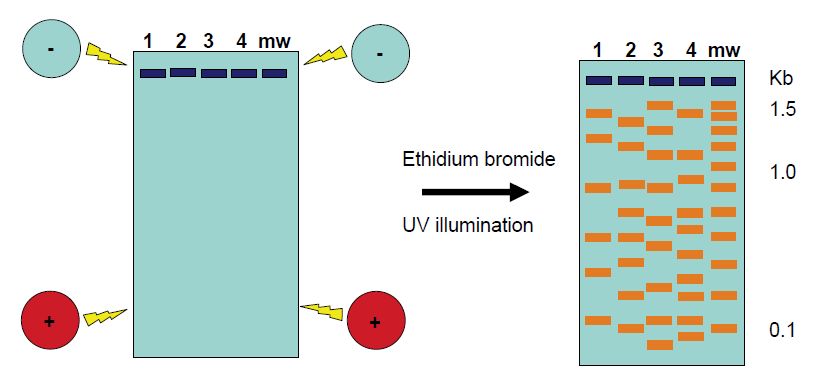


 النبات
النبات
 الحيوان
الحيوان
 الأحياء المجهرية
الأحياء المجهرية
 علم الأمراض
علم الأمراض
 التقانة الإحيائية
التقانة الإحيائية
 التقنية الحيوية المكروبية
التقنية الحيوية المكروبية
 التقنية الحياتية النانوية
التقنية الحياتية النانوية
 علم الأجنة
علم الأجنة
 الأحياء الجزيئي
الأحياء الجزيئي
 علم وظائف الأعضاء
علم وظائف الأعضاء
 الغدد
الغدد
 المضادات الحيوية
المضادات الحيوية|
Read More
Date: 5-5-2016
Date: 1-6-2021
Date: 16-3-2021
|
Restriction Endonuclease Analysis (DNA Fingerprinting)
Restriction enzymes are a group of enzymes that each can recognise a short double-stranded DNA sequence of 4–9 base pairs (bp) and cleave the DNA at this site. The enzymes work by cleaving the bonds in the phosphate backbone of the DNA molecule. Depending on the exact DNA sequence of the bacterial genome, different mixtures of restriction fragments will result following digestion with one or more defined restriction enzymes. The restriction fragments can be separated using agarose gel electrophoresis and ethidium bromide staining followed by visualisation of the separated restriction fragments (DNA bands) under UV light. A ‘DNA fingerprint’ can thus be obtained for each species of bacterium. The method requires relatively large amounts of purified DNA and the resolution is not high.

Figure : Schematics of pulse field electrophoresis. Restriction enzyme-digested DNA is loaded into wells and separated in the agarose gel by electric fields that alternate between the poles every 90 s for 24 h. UV illumination visualises DNA with intercalating ethidium bromide. Different samples have been loaded in wells 1–4 and a size marker in the rightmost lane.



|
|
|
|
دراسة يابانية لتقليل مخاطر أمراض المواليد منخفضي الوزن
|
|
|
|
|
|
|
اكتشاف أكبر مرجان في العالم قبالة سواحل جزر سليمان
|
|
|
|
|
|
|
المجمع العلمي ينظّم ندوة حوارية حول مفهوم العولمة الرقمية في بابل
|
|
|